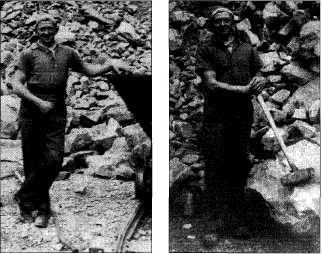| JOURNAL 2003 |
| North Craven Heritage Trust |
When I was a young child in the early sixties I had strong memories of what Settle used to be like and about some of the old people that used to live and work in Settle. The highlight of my week was when my mother took me to the bus stop outside the Naked Man where I would catch the old Pennine bus up to Giggleswick lime works. At that time my father worked there on the weighbridge which was opposite the turn off to Giggleswick and he would meet us there. Just above where he was working there were some huge coal fired kiln chimneys that puffed plumes of thick acrid smoke. They could be seen for miles around and caused a great number of complaints. The weigh-' bridge as I remember it was very small and large wagons had to weigh the front and then the back because they couldn't fit on the scales. The lime had a reputation to be amongst some of the best in Europe. It was used in the steel industry, which in the sixties was a major business. Two wagons ran to the sidings all day long. The drivers that I can remember were Alan Burrows and Tant Marklew. Norman Parry worked in the weighbridge along side my father.
The house opposite the weighbridge belonged to the manager of the quarry who was Mr Ernest (Bunny) Marklew. One of the jobs my dad did was to take the men's clean overalls out to the bottom cabin and the men handed in the dirty ones as they clocked off. The people I can remember in there were Bud Ralph, Andy Lynn, Herbert Metcalfe and Wilson Bradley.
In the cabin there was a large stove. It was 15 to 20 feet long and was always red hot as they had a good supply of coal at the quarry for the kilns. The top of the stove was covered with cans warming for dinner.
When the clean overalls were put out we would climb a huge flight of stone steps. We would then arrive at the top cabin, this also had a huge stove. This is where the breakers and fillers would eat. Their job was to break the stone into a manageable size.
They would then load it into a Jubilee truck which sat on a narrow gauge rail track, which the men had to lay themselves. When a truck was full it would be pushed over to the kiln for burning. If all the stone went through a metal hoop the man would get extra bonus If it didn't it was taken back to the face and no bonus at all. Every so often a truck would be pulled off and tipped out for a random check. The stone was very hard. The young inexperienced fillers would hit it till it was round. The old timers would look for a seam hit it in just the right place and it would disintegrate. They had to be very strong as the hammers would weigh in excess of 20 lbs. The most revered of all breaker and fillers was a man called August Bredacus who could load huge quantities per day by hand. Other people I remember are Ronnie Newhouse, Fred Marklew, Jack Parker, Dabby Ralph, Doug Firth, Phillip Jackson, Billy Phillipson, Thomas (Tucker) Ralph, Joe Kelly, Adam Cockell and Peter Lund. I am sure there are others I have forgotten to mention.
Stones that were too big to break by hammer were drilled and a small explosive charge was put in and fired (popped). The men who tended the kilns were called lime-drawers. They kept the kilns feed with coal and drew off the lime when it was burnt. This was a horrible job as the heat was tremendous and the lime would burn the men.
Giggleswick was one of the last quarries to use the manual breaking and filling method that they eventually gave up in the late 60s. Crushers, face shovels and dumpers replaced them. The kilns were shut and dismantled in 1971. The steel industry was in decline - it had taken most of the lime produced at Giggleswick. Lots of jobs were lost.
Today I work at Tarmac's Swinden quarry. It is one of the most modern anywhere, with machines and plant that cost millions. I look back at how things used to be done at places like Giggleswick I am amazed at the way people worked also the amount they processed with the equipment available.

J2003p10_19_files/tmp10CB-1.jpg
(Left) Cuthbert Milward next to Jubilee truck and its narrow rails. (Right) Cuthbert Milward with a 20 lb hammer. Note that he wears clogs.